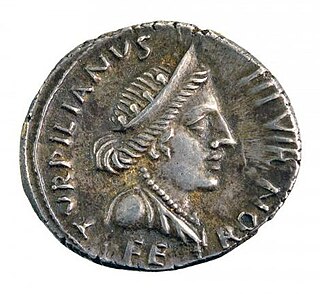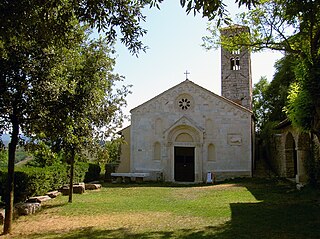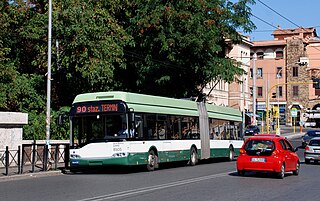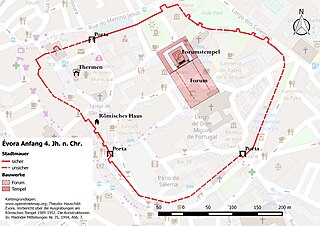
Hispania Tarraconensis was one of three Roman provinces in Hispania. It encompassed much of the northern, eastern and central territories of modern Spain along with modern northern Portugal. Southern Spain, the region now called Andalusia was the province of Hispania Baetica. On the Atlantic west lay the province of Lusitania, partially coincident with modern-day Portugal.

Cures was an ancient Sabine town between the left bank of the Tiber and the Via Salaria, about 26 miles (42 km) from Rome, in central Italy. Its remains are located in the modern commune of Fara Sabina. According to legend, it was from Cures that Titus Tatius led to the Quirinal the Sabine settlers, from whom, after their union with the settlers on the Palatine, the whole Roman people took the name Quirites. Another legend, related by Dionysius, connects the foundation of Cures with the worship of the Sabine god Quirinus, whence Quirites.

In Etruscan and Sabine religion, Feronia was a goddess associated with wildlife, fertility, health, and abundance, also venerated by the Faliscans and later adopted into ancient Roman religion. As the goddess who granted freedom to slaves or civil rights to the most humble part of society, she was especially honored among plebeians and freedmen. Her festival, the Feroniae, was November 13 during the Ludi Plebeii, in conjunction with Fortuna Primigenia; both were goddesses of Praeneste.

Hispellum was an ancient town of Umbria, Italy, 6 km (3.7 mi) north of Fulginiae on the road to Perusia.

Tarraco is the ancient name of the current city of Tarragona. It was the oldest Roman settlement on the Iberian Peninsula. It became the capital of Hispania Tarraconensis following the latter's creation during the Roman Empire.

Rieti is a town and comune in Lazio, central Italy, with a population of 47,700. It is the administrative seat of the province of Rieti and see of the diocese of Rieti, as well as the modern capital of the Sabina region.

Lucus Feroniae was an ancient sanctuary or, literally sacred grove ("lucus"), dedicated to the Sabine goddess Feronia, protector of freedmen, ex-slaves. It was located near to the ancient town of Feronia in Etruria on the ancient Via Tiberina, in what is now the territory of the modern commune of Capena, Lazio.
Ricina or Helvia Recina was a Roman town located in the lower Potenza valley, the contemporary Italian region Marche.

Oderzo is a comune with a population of 20,003 in the province of Treviso, Veneto, northern Italy. It lies in the heart of the Venetian plain, about 66 kilometres to the northeast of Venice. Oderzo is crossed by the Monticano River, a tributary of the Livenza.

Forum Novum was a new Roman foundation which developed as a forum or market center during the Roman Republic period. By the early 1st century AD Forum Novum had been elevated to the status of municipium, appearing as such in Pliny's list of towns. It is located within today’s commune of Torri in Sabina in the province of Rieti.

Feronia or Lucus Feroniae was an ancient town near the present town of Fiano Romano. It is located in the plain along the Tiber river, at the foot of Mount Soracte, and was within the ancient territory of Capena. It began as a sanctuary called Lucus Feroniae in the time of Tullus Hostilius when it was located in Etruria.

Martinsicuro is a town and comune in province of Teramo, Abruzzo, central Italy. It is located on the right of the mouth of Tronto River.

Suasa was an ancient Roman town in what is now the comune of Castelleone di Suasa, Marche, Italy. It is located in the Pian Volpello locality, in the valley of the Cesano River.

Monteleone Sabino is a comune (municipality) in the Province of Rieti in the Latium region of Italy, located about 45 kilometres (28 mi) northeast of Rome and about 20 kilometres (12 mi) south of Rieti.

Eretum, was an ancient town of the Sabines, situated on the Via Salaria, at its junction with the Via Nomentana, a short distance from the Tiber, and about 30 km (19 mi) from Rome.

Carteia was a Phoenician and Roman town at the head of the Bay of Gibraltar in Spain. It was established at the most northerly point of the bay, next to the town of San Roque, about halfway between the modern cities of Algeciras and Gibraltar, overlooking the sea on elevated ground at the confluence of two rivers, nowadays called Guadarranque and Cachon.

The Segusiavī were a Gallic tribe dwelling around the modern city of Feurs (Auvergne-Rhône-Alpes) during the Iron Age and the Roman period.

The Vindelici were a Gallic people dwelling around present-day Augsburg (Bavaria) during the Iron Age and the Roman period.

Municipio Roma III is the third administrative subdivision of Rome (Italy).

Ebora Liberalitas Julia is the name of a Roman municipium that gave rise to the Portuguese district capital Évora in the Alentejo region. While the name "Ebora" indicates a Celtiberian hill top fortification in the area of the later municipia or in its vicinity the first archaeological evidence of a settlement is from the Early Roman Empire. Early Roman activities on the Iberian peninsula were limited to the areas previously partially populated by Greeks and Punic areas along the south and east coast. The area of today's Alentejo probably did not come under Roman control until the middle of the 2nd century BC. The name addition "Iulia" in the Roman name Évoras infers the emergence of the municipium under the Julians and their representative Gaius Iulius Caesar. But since clear traces of extensive infrastructures from this time and in the surrounding area are missing, it is considered more probable that Évora only came into being as a municipium after the Pax Romana under Octavian in 30 BC. The suffix "Liberalitas Iulia" should be interpreted in this context as an indication of peace. The first reference to Évora as a municipium is found in a list of cities in Hispania in the Historia Naturalis of Pliny the Elder to the year 77 A.D.






















